Ending Breed Discrimination
Check out our award winning, myth-busting PSA!
Support Pit Bull Education & Advocacy
At HSHC, we believe every dog deserves a fair chance—regardless of breed. We do not discriminate against Pit Bulls (or any other breed) because every dog should be judged by its temperament and personality, not by stereotypes.
In partnership with J.C. Hart Apartment Communities, we dedicate the month of March to Pit Bull Education Month, a time to challenge misconceptions, share the true history of the breed, and advocate for the American Pit Bull Terrier.
How You Can Help
Donate – Your support provides care, shelter, and advocacy for Pit Bulls in need.
Adopt – Open your home to a pittie looking for love. For the month of March all Pit Bull adoptions (age 1 year and older) are only $25
How to Give the Breed a Better Name
Adopt a Pit Bull
63% of the dogs HSHC receives are pit bulls, bully breeds and other special breeds – 53% of which are specifically pit bulls. They make up the majority of dogs entering the shelter system due to breed discrimination and misperceptions. Pit bulls also represent the largest number of victims of animal cruelty and neglect arriving at our shelter.
Foster a Pit Bull
On average, bully breeds spend more time waiting for a home. In 2022, bully breeds waited an average of 38 days, compared to the overall average of 23 days. Fostering gives these dogs a break from the stressful kennel environment and a better chance to find a loving home.
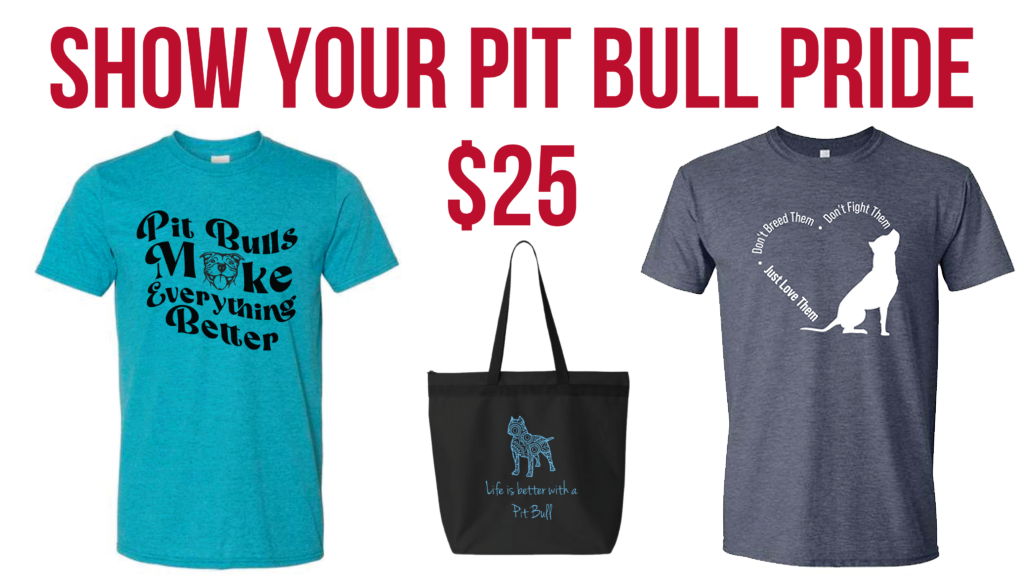
Stop by HSHC to purchase Yours! Get Directions
Learn More About the American Pit Bull Terrier
Just walking down the street with a Pit Bull on the leash is an interesting way to find out how many different types of pit bulls exist — in people’s minds. Some folks rush over to coo and praise; others hurry to the other side of the street to avoid close contact. Many just study the dog as it walks past – while drinking in a good long (often confused!) look at the person on the other end of the leash. This is one breed that evokes strong emotion and bigger controversy wherever it wags its tail. The range of opinion in the Pit Bull Drama varies so dramatically that the average person is often left with nothing more than confused ideas gleaned from the warnings of television news reporters.
Understanding the breed starts with learning about their beginnings on up to the roles they play in our society today. They’ve traveled a long road with Americans since early colonists went to the trouble of importing them along with their other family treasures. With the same courageous spirit, tenacious loyalty and die-hard devotion they provided to their owners generations ago, they continue to dutifully hold up a mirror to this American society and reflect back to us who we are as a culture of dog owners.
Created in England
The dog that we now recognize as the pit bull was originally bred in the British Isles early 100’s to ‘bait’ bulls. These matches were held for the entertainment of the struggling classes; a source of relief from the tedious and brutal way
of life suffered by many commoners during that time. In 1835 bull baiting was deemed inhumane and became illegal, and dog fighting became a popular replacement.
The best fighters were celebrated and held up as heroes for their courage and fortitude during battle. At the same time, a very strong bite inhibition towards humans was encouraged through selective breeding so handlers could lean over into the fighting pits and pull their battling dogs apart without worrying about receiving a redirected bite. Partially because of these breeding efforts to which culled out “man biters”, Pit Bulls became well known for their loving devotion and trustworthy nature with humans…and even garnered the nickname “nanny dog” for their love and protective nature over children.

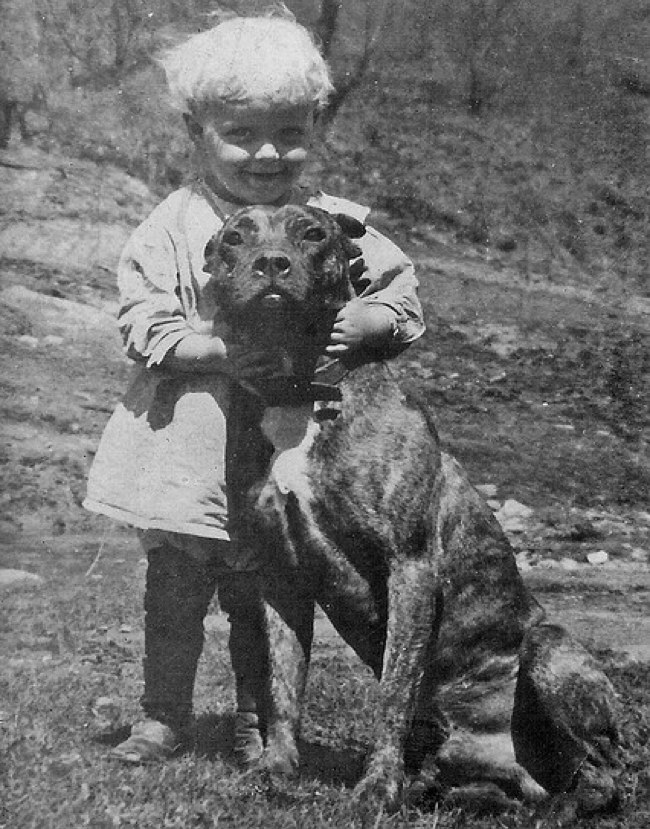
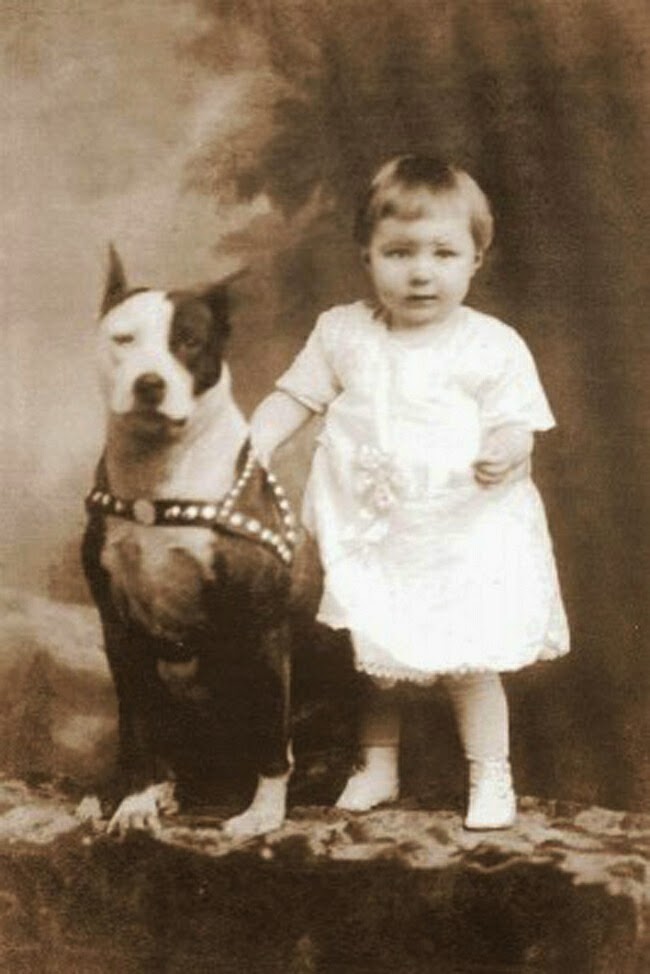
History in America
Immigrants brought their dogs across the ocean along with their families and prized possessions. They soon became a fixture in a developing nation. In early America, the dogs were valued for much more than their fighting abilities. They were entrusted to protect homesteads from predators and worked as vital helpers on family farms. Homesteaders depended on their abilities to help in hunts and as hog catchers (hence, the common title “catch dogs”). They were constant companions to the young children who were entrusted in their care. Pit Bulls earned their place as an important part of the fabric of a developing nation.
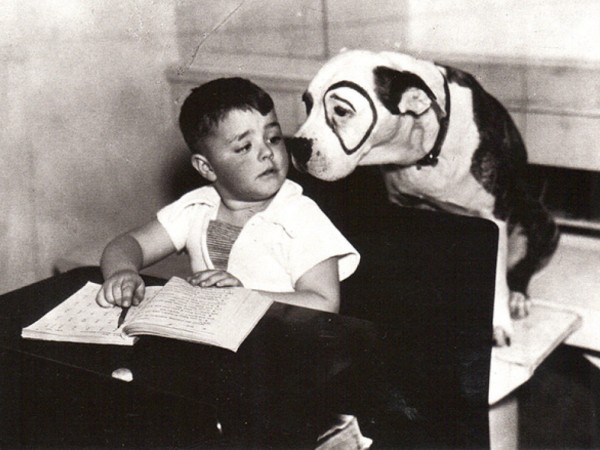
The Pit Bull was also a favorite dog among politicians, scholars, celebrities. Helen Keller, Theodore Roosevelt, and the “Our Gang” Little Rascals all had APBTS. Many reading this website may have grandparents and great grandparents who kept a favorite Pit Bull as a pet. Today, this tradition continues with tens of thousands of Americans who love and cherish their family Pit Bulls.
Although we’ve changed enough as a culture to create laws which protect our admirable clown from organized dog fighting, ironically the darkest hour of this breed’s story has only come about in the past 20 years. While huge numbers of Pit Bulls in this country are cherished family pets, many not so fortunate suffer the consequences of a nation with multi-layered social and economic problems.
The historic fighting ability of this All American breed began to be exploited on a larger scale in the 1980’s. Pit bulls were soon associated with poverty, crime, and newspaper headlines of back alley dog fighting rings. And, for the first time in the breed’s history, we started hearing disturbing accounts of bites and attacks on humans by poorly socialized and badly bred APBTs, APBT mixes and other breed dogs that were mislabeled as APBTs. The press went wild, the public panicked, and the reputation of the entire breed was dragged down with sensationalistic headlines and a few rotten examples of “Pit Bull Imposters” owned by shady and irresponsible owners.
To add to the sadness, a frenzy of backyard breeding of Pit Bulls in our urban cities began to add to the burgeoning population of unwanted dogs in the 80’s — a trend which continues today. The economic incentive of a 50 dollar price for unpapered pit bull puppies has filled our newspapers with ads for “Pit Pups for Sale”.
Those seeking a status symbol or controversial fashion statement are irresistibly drawn to having a pit bull of their own. But just as fashions change, so do the minds of many ‘casual pit bull owners’. The pattern of Pit Bulls purchased for breeding, later discarded and then duly euthanized by our overcrowded shelters has erupted into a disturbing ‘business as usual’ cycle with no end in sight.
With a negative reputation as “mean and vicious” animals, chances of salvation for most unwanted Pit Bulls are depressingly slim.
So, just as we struggle as a nation to understand how to deal with the social and economic ills that affect our cities, we are also left with the sticky puzzle of what to do about our once favorite breed of dog that is so feared and so loved at the same time.
Once again, the APBT breed reflects back to us who we are: a culture of incredible contrasts and conflicting beliefs.
Source: www.BADRAP.org
The most notable traits of pit-bull-type dogs, including their great love for people and their potential for dog aggression. You will learn that pit bulls make wonderful and loyal family companions. Like all dogs, they require intelligent, responsible, and dedicated ownership. Because of the breed’s undeserved negative media image, pit bull owners have to be even more careful and responsible than the average dog owner.
They must also be aware of the myths (urban legends, really) surrounding their dogs. Owners must be well educated about bully breeds, because they will likely face comments from friends, families, and neighbors.
Unfortunately, some people obtain pit bulls for the wrong reasons—to boost their own image, for dog fighting, or for backyard breeding—which makes life difficult for responsible owners. The good news is that pit bulls are now more popular than ever, and each good owner has an opportunity to reshape the breed’s image in positive ways.
When you adopt a pit bull, you adopt the most energetic, intelligent, and loyal friend you’ll ever have, but you also take up a responsibility to represent the entire breed.
It’s unfortunate that one of the original purposes of the pit bull was dog fighting, but it is a fact that cannot be denied or ignored. Even more unfortunate is the fact that they are still chosen for this purpose, even though it is illegal in all fifty states and, in certain instances, as the Michael Vick case illustrates, a federal crime.
Adopting a pit bull, loving it, and training it as a breed ambassador are the most important things any of us civilians can do to combat people like Vick.
PBRC does not wish to overemphasize the fighting aspect of the breed’s history, a history that does not negate their various positive traits or their scientifically proven gentleness toward humans. But we do acknowledge the importance of respecting the breed’s history.
This is not to suggest that pit bulls are “different” or “unique” in a way that makes them dangerous. Those who claim that pit bulls are “different” fail to understand that all dog breeds are, in some way, different from each other. That’s what makes them dog breeds! (Besides, many breeds were historically bred to fight other animals. Pit bulls are not unique in this sense.)
To put it simply, no matter what kind of dog you have, understanding its breed is the first step toward being a good dog owner. By nature, pit bulls are intelligent, fun loving, and affectionate. It’s our job to help them fulfill that potential.
Pit bulls are wonderful, loving animals that deserve the chance to have a good life.
Pit bulls have superior physical and mental characteristics that make them excellent partners for responsible, active, and caring owners. These same outstanding qualities can, however, make them a little difficult to handle for people who don’t have a lot of experience with dog ownership or for those who don’t understand the breed well.
Luckily, pit bulls are intelligent, very responsive to training, and, above all, eager to please. Therefore, pit bulls should be enrolled in obedience classes as soon as they are up-to-date on their shots. (Pit bulls are more susceptible to parvovirus, so it is important that they receive all their vaccinations before coming into contact with other dogs or entering areas of high canine traffic.)
A well-behaved pit bull is the best ambassador for the breed. As we’ve already noted, this is the easiest way to fight breed prejudice and misconception.
Pit bulls are quite resilient and can do well in an urban environment, provided they have enough exercise and other positive outlets for their energy. Many pit bulls are easygoing couch potatoes, but like all terriers, they can also be somewhat rambunctious until they mature.
Maturity can come relatively late with this breed (two to three years old in some cases). Pit bulls remain playful throughout their lifespan (nine to fifteen years) and have a great sense of humor. True clowns at heart, these dogs will make you laugh like no other.
Pit bulls serve society in many roles in addition to a loyal companion:
- Search and rescue
- Therapy dogs visiting hospitals and senior communities
- Working in law enforcement as narcotics and bomb detection dogs
- Educational dogs teaching children about canine safety
- Service dogs
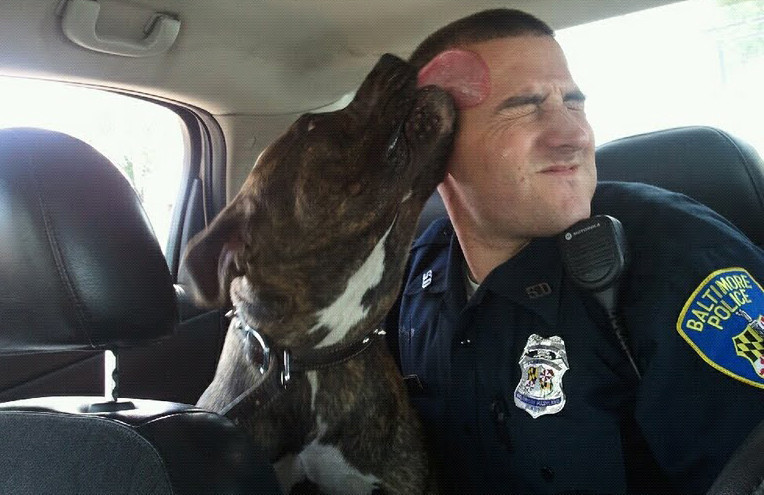
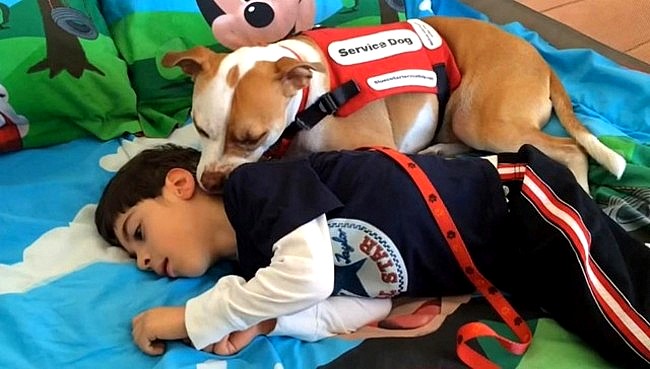
Source: PBRC.net
Perhaps the most important characteristic of pit bulls is their amazing love of people. Many people are surprised by the loving personality of these dogs the first time they meet one. Pit bulls are remarkably affectionate and truly enjoy human attention. They are wonderful cuddlers and love nothing more than a belly rub. In fact, most pit bulls think they are lap dogs! 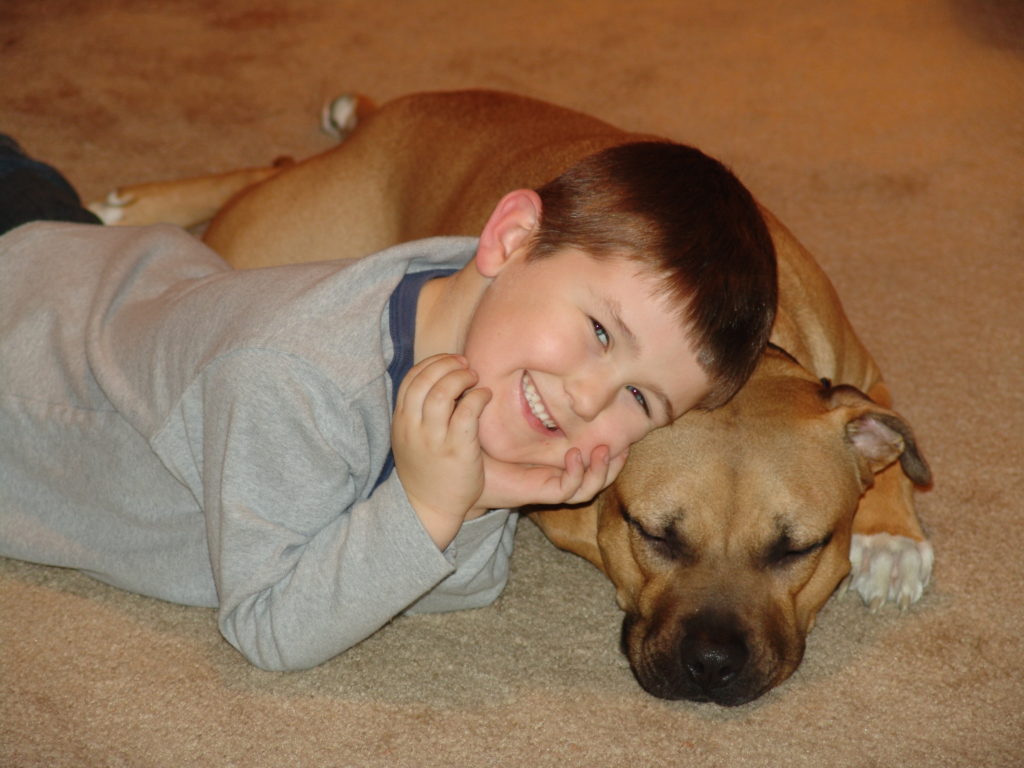
As Dunbar (1999) writes, “Today, a properly bred pit bull is so exuberantly happy upon meeting her owner’s friends (or even friendly strangers) that new owners sometimes worry that their dog is too sweet and fun-loving to protect their home and family… A multi-talented companion, the well-trained pit bull is suited for a variety of exciting activities. He excels at obedience, agility and weight-pulling competitions, events which showcase intelligence, trainability and strength. In addition, the pit bull’s pleasant nature makes him an ideal candidate for therapy work with people.”
Traits like human aggression, severe shyness, and instability are not typically found in the APBT breed, nor are they acceptable. Dogs with these traits are not good representatives of the breed and should not be placed into adoptive homes.
Those who wish to label these breeds as “dangerous” are often quick to insist that the dog fighting aspect of their history somehow means that they are inclined to “fight” humans. This is simply wrong. A central fact of pit bulls’ history is that their lineage actually makes them less inclined to be aggressive toward humans. For over 160 years,they have been systematically bred away from human aggressiveness. As Malcolm Gladwell (author of The Tipping Point, Blink and Outliers) explains in an article published in The New Yorker in 2006: Pit bulls were not bred to fight humans.
On the contrary: a dog that went after spectators, or its handler, or the trainer, or any of the other people involved in making a dog fighting dog a good dogfighter was usually put down.
So while human aggressive pit bulls were actively culled from bloodlines, traits such as gentleness, temperamental stability, and the desire to be handled by humans were emphasized. These qualities are the foundation of the “pit bull” breeds.
It explains why footage of pit bulls being rescued from horrific circumstances usually features skinny, scarred-up dogs with wagging tails and happy tongues joyfully greeting law enforcement officers.

What is “essential pit-bullness”? It’s difficult to express the personality of any breed in words, but for pit bulls it comes down to a certain joie-de-vivre and a magnetic attraction to humans. First, pit bulls have a constant desire to be close to humans, even if that means lying by your feet as you use the computer; they are not overly independent dogs and want nothing more than to be active members of your “family.”
Second, pit bulls are outgoing, eager to meet new people, and generally trusting of strangers. Finally, this innate desire for human contact and outgoing nature adds up to the ultimate “people dog”: pit bulls are truly in their element when snuggling on the couch, hopping in the bed on a cold morning, getting rubbed on the belly or scratched behind the ears, showing off a trick, going for a car ride with their family, or playing a fun game.
Contrary to myths propagated by the media, human aggression occurs in all dog breeds. Canines can exhibit many kinds of aggression: human-, dog-, territory-, and food-aggression, to name a few. These are independent behaviors.
For example, feral dogs can be good with other dogs but highly aggressive toward humans. By the same token, a dog with dog aggression isn’t by default also human aggressive. Pit bulls test well above average in temperament evaluations.
Source: PBRC.net
Never trust a dog not to fight. That means any dog! Dog aggression is not a breed-specific behavior. Dogs of any breed can exhibit intolerance toward other dogs.
Dogs may fight over hierarchic status, food, toys, or rawhides. External stimulus or excitement can also trigger a fight. Remember that any canine can fight, regardless of breed. If you frequent a dog park, you’ve surely seen a fight occur among a pack of dogs for reasons not discernible to humans.
Owners should separate their dogs if they cannot closely supervise them. For pit bull owners, the stakes are always higher. While they may not instigate a fight, they won’t back down from a challenge. Inevitably, no matter who “started it,” no matter what the circumstances, the pit bull will always be blamed. Each incident in which a pit bull gets blamed jeopardizes our right to own these great dogs. Keep your dog out of trouble!
That said, many pit bulls get along great with other pets and may live happily with other dogs without incident. We simply cannot assume that this is true for all of them.
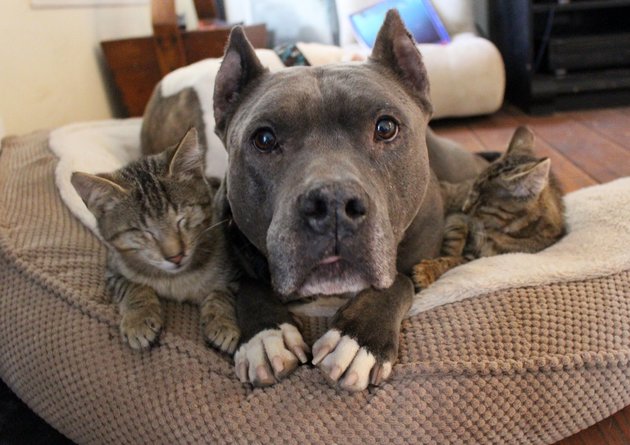
The same goes for all other breeds, and none of this should suggest that, in the language of popular myth, pit bulls are more likely to “snap” or “turn”. It only means that their attitude toward other dogs may change as they mature.
Pit bull owners must show common sense by ensuring that they don’t set their dogs up to fail by putting them in inappropriate situations. It is every dog owner’s responsibility to ensure that they are managing their dog’s needs and looking out for their dog’s safety at all times.
Source: PBRC.net
Fear:
Pit Bulls have “locking jaws.”
Fact:
“We found that the American Pit Bull Terriers did not have any unique mechanism that would allow these dogs to lock their jaws. There were no mechanical or morphological differences . . .”
Dr. I. Lehr Brisbin, University of Georgia
Fear:
Pit Bulls have massive biting power measuring in 1,000s of pounds of pressure per square inch. (PSI)
Fact:
On average, dogs bite with 320 lbs of pressure per square inch. The bite pressure of a German Shepherd, an American Pit Bull Terrier and a Rottweiler were tested. The American Pit Bull Terrier had the least amount of bite pressure of the three dogs tested.
Dr. Brady Barr, National Geographic
Fear:
Pit Bulls just “snap” and attack without warning.
Fact:
“Pit Bulls signal like other dogs.”
The Institute of Animal Welfare and Behavior of the University of Veterinary Medicine, Hannover, Germany temperament tested over 1,000 dogs.
Fear:
Pit Bulls are “ticking time bombs” that turn on their owners.
Fact:
“No single, neutered household pet pit bull has ever killed anyone.”
Karen Delise, LVT, independent scholar, and Author.
Fear:
While there are some pit bulls with good temperaments, they are the exception not the rule.
Fact:
The American Temperament Test shows pit bulls consistently score above the average for all breeds tested, year in and year out!
The American Temperament Test Society, www.atts.org
Fear:
Pit Bulls are more dangerous than other dogs.
Fact:
“A dog is only as dangerous as its owner allows it to be.”
Diane Jessup, Founder of LawDogsUSA, Author, retired Animal Control Officer.
Source: WWW.ANIMALFARMFOUNDATION.ORG
The American Temperament Test Society, Inc. (ATTS) is a national not-for-profit organization (registered in the state of Missouri) for the promotion of uniform temperament evaluation of purebred and spayed/neutered mixed-breed dogs. They conduct temperament testing of hundreds of dogs each year.
A detailed listing of breed scores and test sample sizes may be found at www.atts.org.
In 2019, the American Pit Bull Terrier scored better on temperament testing than:
- Border Collies
- Boxers
- Cocker Spaniels
- Collies
- Dobermans
- German Shepherds
- Golden Retrievers
- Rottweilers
- Saint Bernards
- Weimaraners
Just to name a few!
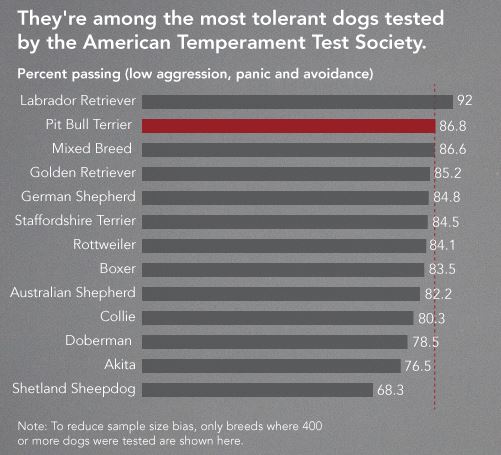
Breed specific legislation is exactly what sounds like…regulation of your right to own or, in many cases, not own a dog based solely on the breed or “type” of dog, not your responsibility as an owner. The result of BSL is the systematic killing of all dogs, regardless of temperament or age, who even look like a pit bull. With over 25 other breeds who have similar “bully” characteristics such as a big head, broad chest and muscular stature, many dogs are often mistaken for Pit Bulls who are not which means they too will be euthenized.
In cities where BSL has been implemented, personal pets owned without issue or incident regardless of age or circumstance were required to be relinquished and euthanized. This discriminatory practice affects the responsible pet owners who are not the source of the problem or reports we see in the media. The criminals and irresponsible pet owners who harbor unimmunized, unaltered dogs who spend their lives chained out in yards or running at large are not going to follow a BSL ordinance either.
BSL punishes responsible pet owners and sets forth only to kill innocent family pets who have committed no crimes.
Even in counties where there are no breed specific ordinances, policies still exist that mandate the unnecessary killing of these dogs in animal control agencies due to a lack of education, ineffective screening and temperament testing procedures, and poorly enforced dangerous dog laws.
Breed specific ordinances are typically implemented as knee jerk reactions to a dog bite occurrence.
BSL is not a sufficient long term solution for the following reasons:
- Dog problems are generally problems with owner responsibility and are not limited to breeds. When breeds are singled out as dangerous or vicious, responsibility is removed from the dog owner which is where it belongs. Irresponsible people are also less likely to follow the law – and as a result, everyone has to suffer.
- By limiting the ability of citizens to own certain breeds, responsible law abiding citizens will shy away from those breeds. These are the types of owners that communities need to encourage, not drive away.
- Communities that have instituted such bans often find that the irresponsible owners and the criminals who use dogs for illegal purposes simply switch to another breed.
- Breeds and mixes are hard to identify and often dogs are mis-labeled and destroyed based on paranoia and prejudice and also punishes those that are good canine citizens. Many breeds function as assistance dogs for handicapped owners, search and rescue dogs, drug-sniffing dogs, police dogs, etc. and drives them out of the community. The American Veterinary Medical Association, the Humane Society of the United States, the ASPCA and several state veterinary medical associations oppose breed-specific legislation for just this reason.
- The dog most restricted is the “pit bull.” A pit bull is a type of dog, not a recognized breed. The “Pit Bull” is only a generic name that encapsulates the American Pit Bull Terrier, Staffordshire Terrier, American Staffordshire Terrier and Bull Terrier.
Passage of laws that are only enforced through complaints cause two problems:
- They create disrespect for the law if authorities require compliance only upon complaint.
- They provide ammunition for neighborhood feuds.
Suggested alternatives to breed bans include:
- Stronger enforcement of existing dangerous dog laws. If they are not already in place, lobby for protection from untrained and unsupervised dogs of any breed or mix. This is a broad-based effort that protects all citizens as any dog can bite and be a nuisance when owned by an irresponsible owner. Those who would deliberately train a dog to act aggressively towards people or other animals, or to use dogs in the commission of a felony or misdemeanor should face additional penalties.
- Encourage local animal rescue and welfare agencies to provide responsible dog ownership seminars and canine safety education. The American Kennel Club has a free education program created for elementary school children.
- Protect the rights of all citizens with nuisance ordinances such as anti-barking, pooper scooper regulations, leash laws, tethering laws, and mandatory spay/neuter for all breeds unless proper breeder’s permits have been obtained.*Source: PBRC.net, atts.org, *HSHC
Media reports would have you believe that dog bites are on the rise. The reality is the number of dog bites reported has consistently declined in the state of Indiana over the last 20 years.
Some factors that have been proven to contribute to the likelihood of a dog bite include:
- A chained dog is 2.8 times more likely to bite than an unchained dog.
- Canines not spayed or neutered are three times more likely to bite than sterilized ones.
The list of breeds most involved in both bite injuries and fatalities changes from year to year and from one area of the country to another, depending on the popularity of the breed.
The Pit Bull Terrier has consistently increased in popularity over the last 20 years thereby statistically increasing the number of reported bite cases for this breed.
Source: National Canine Research Council, Center for Disease Control and Prevention
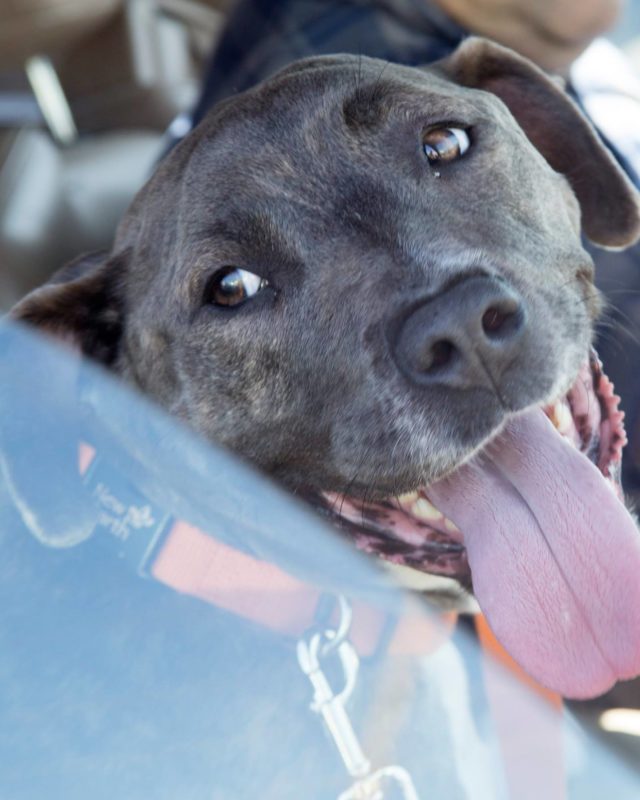
Whats the Truth About Pit Bulls?
A combination of myths, biased media reporting, exploitation of these dogs by criminals, and irresponsible pet owners has created an inaccurate stereotype of the breed and the people who own and love them. Those who adopt these amazing dogs — we call them our Pit Bull Angels — gain loving and loyal family members.




